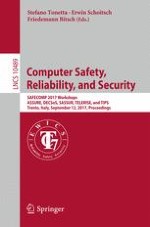This book constitutes the refereed proceedings of five workshops
co-located with SAFECOMP 2017, the 36th International Conference on
Computer Safety, Reliability, and Security, held in Trento, Italy, in September 2017.
The 38 revised full papers presented together with 5 introductory papers to each workshop,
and three invited papers, were carefully reviewed and selected from 49 submissions.
This year's workshops are: ASSURE 2017 – Assurance Cases for Software-Intensive Systems;
DECSoS 2017 – ERCIM/EWICS/ARTEMIS Dependable Embedded and Cyber-Physical
Systems and Systems-of-Systems; SASSUR 2017 – Next Generation of System Assurance
Approaches for Safety-Critical Systems; TIPS 2017 – Timing Performance in Safety Engineering;
TELERISE 2017 Technical and legal Aspects of Data Privacy and Security.
